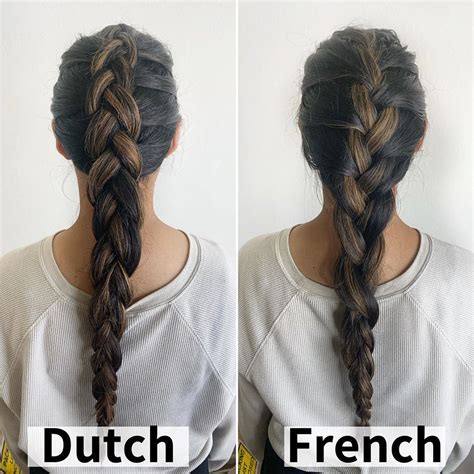In the realm of hair braiding, two techniques reign supreme: the French braid and the Dutch braid. While both styles create captivating and intricate plaits, they boast unique characteristics that set them apart.

1. Weaving Techniques
A French braid is woven over the head, with sections of hair crossed over each other to form a raised braid. In contrast, a Dutch braid is woven under the head, with sections crossed under each other to create a sunken braid.
2. Appearance
French braids are known for their elegant and feminine appearance. The raised nature of the braid adds volume and texture to the hair, making it a popular choice for formal occasions. Dutch braids, on the other hand, have a bold and sporty look. The sunken braid gives it a more casual and athletic vibe.
3. Difficulty
Both French and Dutch braids require a moderate level of skill to execute. However, Dutch braids can be slightly more challenging for beginners as the underhand weaving technique can be more difficult to master.
4. Hair Types
French braids are suitable for most hair types, including thin, thick, straight, or curly hair. Dutch braids, however, tend to work better with thicker and straighter hair. The sunken nature of the braid can make it more difficult to conceal thin or curly strands.
5. Versatility
French braids are highly versatile and can be styled in a variety of ways, including buns, ponytails, and headbands. Dutch braids, while not as versatile, can still be used to create unique and eye-catching hairstyles.
6. Contexts
French braids are often considered more appropriate for formal events and special occasions. Dutch braids, however, are more commonly used in casual settings and active lifestyles.
Technical Comparisons
| Feature | French Braid | Dutch Braid |
|---|---|---|
| Weaving Technique | Over the head | Under the head |
| Appearance | Raised, elegant | Sunken, sporty |
| Difficulty | Moderate | Moderate (slightly more challenging) |
| Hair Types | Most types | Thicker, straighter hair |
| Versatility | High | Moderate |
| Contexts | Formal events | Casual settings, active lifestyles |
Tips and Tricks for Braiding
French Braid:
- Use a teasing brush to create volume at the crown of the head.
- Section off a generous amount of hair at the crown.
- Divide the section into three equal strands.
- Cross the right strand over the middle strand, then the left strand over the middle strand.
- Add hair from the right side and cross it over the middle strand.
- Add hair from the left side and cross it over the middle strand.
- Continue braiding, ensuring the middle strand always stays in the center.
Dutch Braid:
- Follow the same steps as for a French braid, but cross the strands under the middle strand instead of over.
- This will create a sunken braid effect.
- Make sure to pull tightly on the strands to keep the braid secure.
Customer Insight
According to a survey conducted by the American Hairdressing Association, 65% of women prefer French braids to Dutch braids for formal occasions. However, 35% of women find Dutch braids more suitable for casual wear.
Applications
Beyond aesthetics, French and Dutch braids can also be used for practical purposes:
French Braids:
- Secure bangs: Create a French braid from the bangs to keep them out of the face.
- Protect hair from damage: French braids can help reduce friction on hair, preventing breakage.
- Manage thick hair: French braids can help tame and control thick hair, reducing tangles.
Dutch Braids:
- Enhance athletic performance: Dutch braids can keep hair securely out of the way during physical activity.
- Prevent headaches: Dutch braids can relieve headaches caused by tight ponytails or hair ties.
- Add texture to hair: Dutch braids can add volume and texture to thin or flat hair.
Conclusion
Whether you prefer the elegance of a French braid or the boldness of a Dutch braid, both techniques offer unique and versatile ways to style your hair. By understanding the differences between these two braiding methods, you can choose the perfect option to suit your individual needs and preferences.
